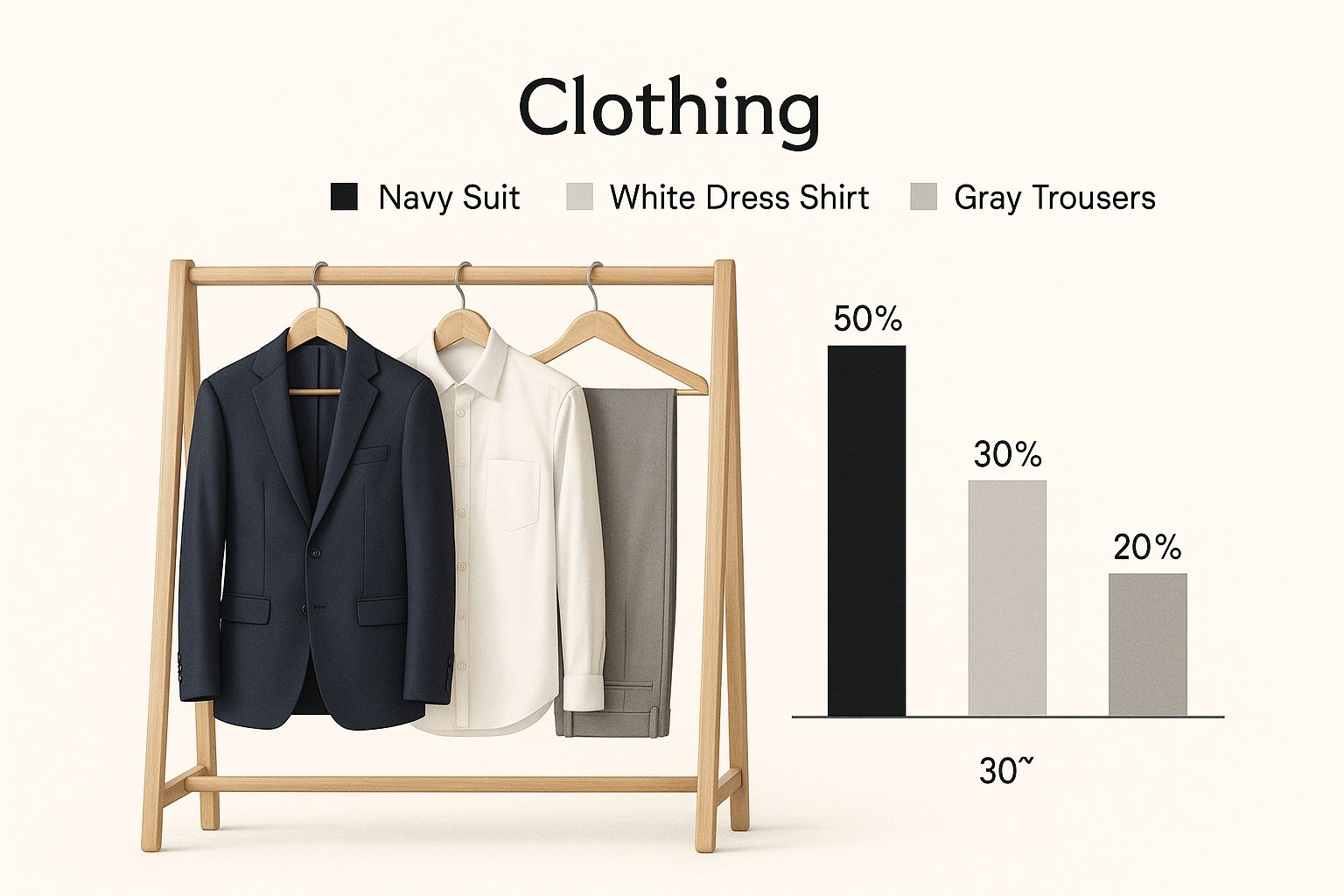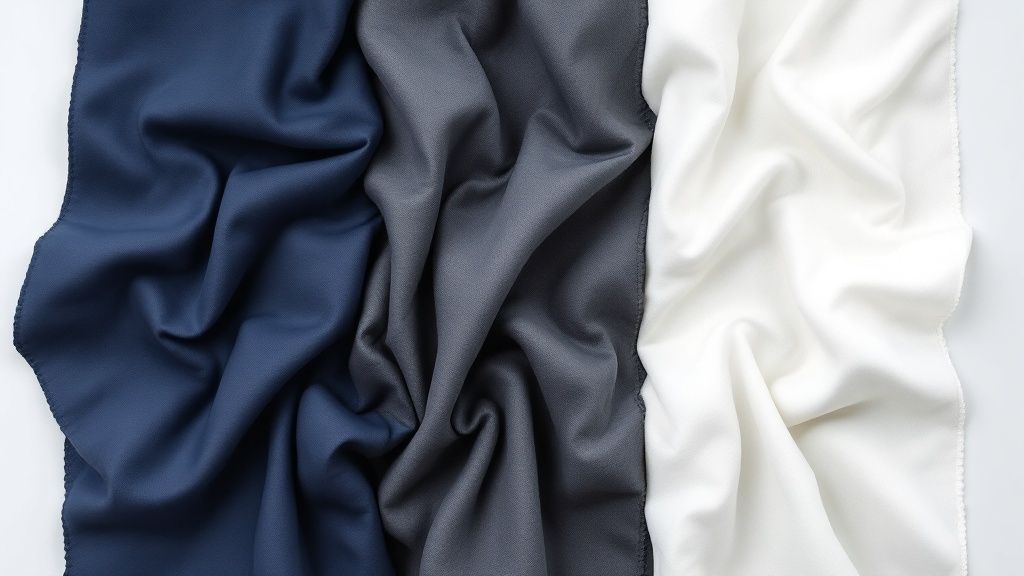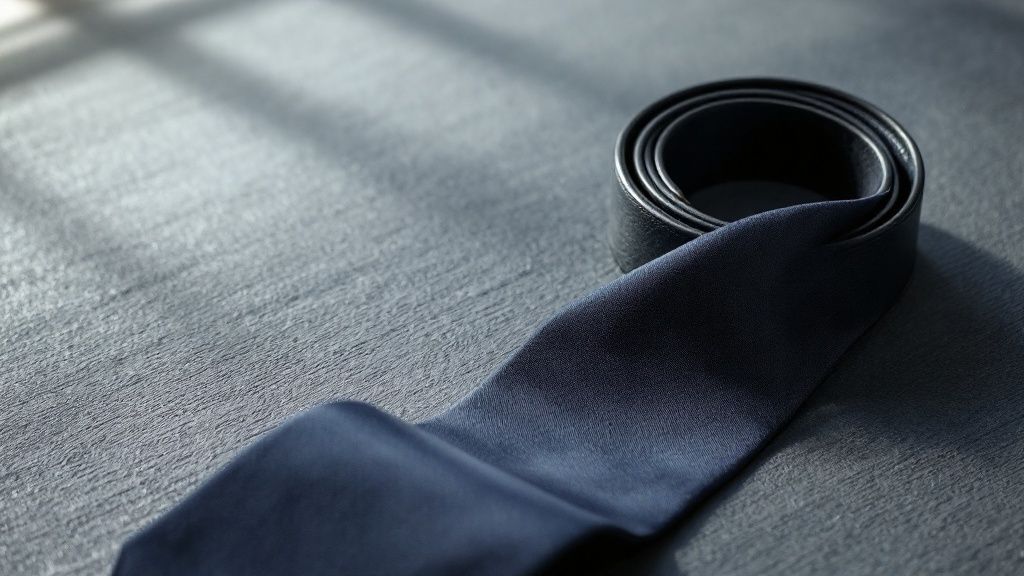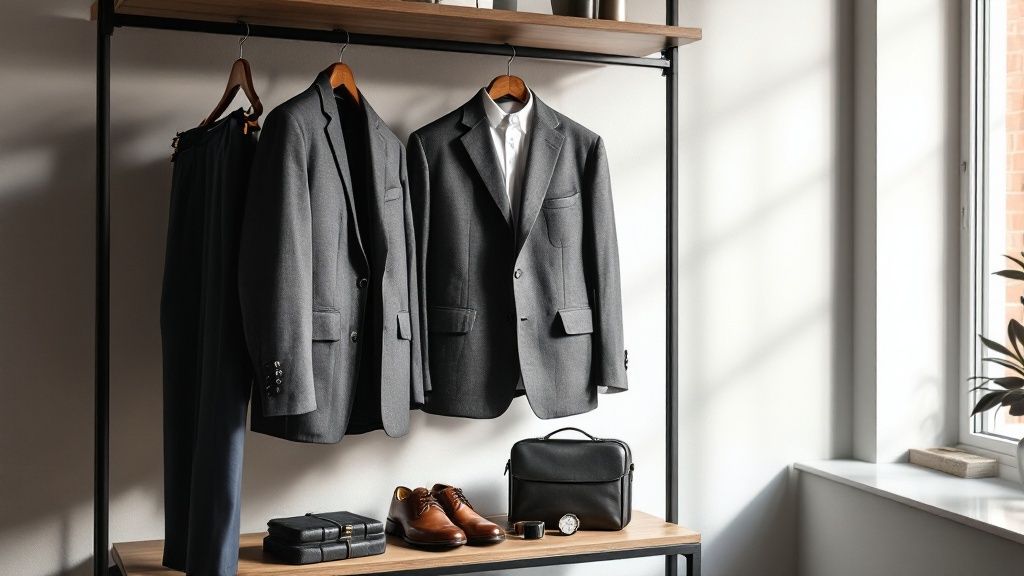The New Rules of Professional Style
The traditional image of professional attire in the UK, the stiff suit and tie or starched blouse and pencil skirt, has evolved. While maintaining a polished appearance is still essential, the modern workplace embraces a more flexible and individual approach. This shift reflects a cultural change towards prioritizing comfort and individuality, without compromising the impact of a well-chosen wardrobe. Smart clothing choices still significantly impact how we are perceived professionally, influencing career advancement and boosting confidence.
Industry-Specific Style
Different sectors within the UK maintain unique expectations regarding dress codes. For instance, the finance industry often adheres to a more formal standard, while creative fields may welcome a more relaxed, expressive personal style. Understanding these unwritten rules within your specific industry is vital for creating an effective professional wardrobe. For a streamlined approach to wardrobe building, consider a capsule wardrobe, a versatile method that simplifies dressing for any occasion.
Balancing Authenticity and Appropriateness
Modern professional style presents a challenge: balancing authentic self-expression with appropriate work attire. The goal is to find the middle ground where your personality shines through while still meeting the general expectations of your profession. This could mean adding personal touches, such as a statement accessory or a distinctive color combination, within a foundation of professional staples.
Navigating Financial Realities
Building a professional wardrobe also requires considering current economic conditions. A striking 77% of UK residents planned to cut back on fashion spending in 2025 due to the rising cost of living, as noted when planning a professional wardrobe in the UK. Detailed statistics are available here. This emphasizes the importance of strategically investing in versatile, high-quality garments. Choosing items that can be mixed and matched to create multiple outfits maximizes value and minimizes the need for frequent purchases. This strategy prioritizes long-term style over short-lived trends, ensuring your wardrobe remains adaptable and effective regardless of economic fluctuations.
Foundation Pieces That Transform Your Work Image

This infographic showcases a minimalist wardrobe. It features a navy suit, white shirt, and grey trousers, highlighting how a few well-chosen staples can make a difference. These core pieces show how a streamlined collection can project a polished and professional image. Building a professional wardrobe relies on investing in key items that offer both versatility and longevity.
The Power of the Capsule Wardrobe
The capsule wardrobe concept has gained popularity in the UK. It's a practical approach to building a professional image. This method focuses on a small number of high-quality, interchangeable items. These can be mixed and matched to create many outfits.
This approach saves you money and makes getting dressed easier. You'll save time and mental energy. A capsule wardrobe helps you look polished and put-together every day. And you won't feel stressed by a closet full of clothes you don't wear.
Essential Building Blocks: Quality Over Quantity
A professional wardrobe isn't about lots of clothes. It's about curating a collection of foundation pieces. These items are the backbone of your work attire. Choose them carefully, considering quality, fit, and versatility. For example, a well-tailored blazer can instantly elevate a blouse and trousers. It creates a sophisticated and professional look.
- Tailored Jacket/Blazer: Choose a classic cut in a neutral colour like navy or black. A well-fitting jacket is essential.
- Trousers: Buy several pairs of well-made trousers. Go for neutral colours and different styles. Classic straight-leg and modern wide-leg are great options.
- Crisp White Shirt: This is a classic that can be dressed up or down. Look for cotton or silk.
- Versatile Dress: A knee-length or midi dress in a neutral colour works for many occasions.
- High-Quality Footwear: Invest in comfortable and stylish shoes. Classic court shoes, loafers, or ankle boots are good choices.
Defining Your Needs
These core items are a good starting point. The ideal number of pieces depends on your needs and work environment. Someone meeting clients daily has different needs than someone in a casual office. Your industry also matters. For insights into timeless pieces, see How to master…. Consider your weekly schedule and work activities. Think about the image you want to project. Then, decide how many of each item you need.
To help illustrate the variety of wardrobe essentials across different industries, take a look at the table below:
Professional Wardrobe Essentials by Industry
A comprehensive breakdown of must-have items tailored to different professional environments in the UK
| Industry | Core Items | Investment Pieces | Accessories | Estimated Budget Range |
|---|---|---|---|---|
| Finance | Tailored suits, blouses, pencil skirts | High-quality watch, leather handbag | Silk scarves, understated jewelry | £500 – £2000+ |
| Law | Suits, blouses, smart dresses | Tailored blazer, briefcase | Classic jewelry, court shoes | £500 – £2000+ |
| Creative Industries | Smart casual separates, dresses | Statement jacket, designer bag | Scarves, unique jewelry | £300 – £1500+ |
| Education | Blouses, trousers, cardigans | Tailored jacket, comfortable shoes | Practical bag, simple jewelry | £200 – £800+ |
| Healthcare | Scrubs, comfortable shoes | Lab coat, stethoscope | Practical watch | £150 – £500+ |
This table highlights how different professional settings call for specific attire. While suits are essential in finance and law, more casual attire is suitable for creative industries. Budget considerations also vary greatly.
Building a Cohesive Collection
Treat your wardrobe like a curated collection. Each piece should play a specific role. By focusing on high-quality foundation pieces, you create a versatile wardrobe. It projects competence and style. You can invest wisely and create a sustainable approach to dressing. This ensures your wardrobe serves you well throughout your career. You won't need to constantly shop for new clothes.
Building a Professional Wardrobe on a Real-World Budget

Creating a polished professional look doesn't have to drain your bank account. It's all about smart shopping and focusing on quality over quantity. This section offers practical advice for building a work wardrobe that fits within current UK budgets.
Prioritizing Purchases: Invest and Economize Strategically
Building a professional wardrobe on a budget requires a strategic approach. Knowing when to invest in essential items and when to save is crucial. Investment pieces, such as a well-tailored suit or a classic trench coat, should be high-quality and timeless. These garments form the core of your wardrobe and will last for years. On the other hand, you can save on trend-driven items or pieces you won't wear as often.
Shopping Smart: Timing and Retailers
Timing is everything when it comes to saving money. Utilize UK end-of-season sales and promotions to snag discounts on quality pieces. Knowing which high street retailers offer professional-grade clothing at reasonable prices is also key. Many UK brands offer excellent quality without the hefty price tag, making stylish work attire accessible to everyone.
You might be interested in: How to master affordable luxury.
Cost-Per-Wear: Calculating True Value
A great way to create a budget-friendly wardrobe is by calculating the cost-per-wear. Divide the item's price by the estimated number of times you'll wear it. This reveals the true value of a garment. A pricier, durable item worn frequently might be more economical than a cheaper item that wears out quickly or isn't versatile.
Avoiding False Economies
Bargain hunting is tempting, but watch out for false economies. Buying inexpensive, poorly made clothes can be more expensive in the long run. These items tend to wear out faster, leading to frequent replacements. This cycle ends up costing more than investing in well-made garments. Plus, low-quality clothing can detract from your professional image.
The UK retail market has always responded to economic shifts. Recent cost-of-living increases have significantly changed consumer spending. Besides cutting back on fashion, many Brits are postponing major purchases like holidays and cars, with 76% making these adjustments. This highlights the importance of affordability and versatility when building a professional wardrobe. For more detailed information, check out these statistics: here.
Budget Frameworks: Tailoring to Your Situation
Different career stages and income levels require different budgeting strategies. A new graduate will have different financial constraints than an experienced executive. Create a realistic budget framework that works for you. This will guide your spending, helping you build a professional wardrobe that reflects your goals while respecting your financial boundaries. Building a professional wardrobe on a budget requires a strategic approach, considering quality, versatility, and mindful spending.
Mastering Colour Strategy for Workplace Impact
Building a professional wardrobe is more than just picking out clothes you like; it’s about creating a cohesive and strategic image. Colour plays a vital role in how you're perceived in the UK workplace. This section explores colour theory and helps you develop a personal colour strategy that complements your brand and meets industry standards.
Understanding the Psychology of Colour
Colours have a powerful impact on our psychology and how we perceive others. In professional settings, specific colours communicate distinct messages. For instance, navy blue often represents confidence and authority, making it a staple in corporate environments. Grey suggests sophistication and neutrality, while black projects power and formality. Understanding these subtle cues allows you to choose colours that convey the right impression.
Creating a Versatile Core Palette
Building a versatile wardrobe starts with a foundation of neutral colours. These adaptable shades are the backbone of your professional look, offering endless mix-and-match possibilities.
- Navy: A timeless and sophisticated alternative to black, navy provides a versatile base for various outfits.
- Grey: From light to charcoal, grey offers a spectrum of options for suits, trousers, and skirts.
- Black: While powerful, black can sometimes be overwhelming. Use it strategically for formal events or as an accent.
- Beige/Cream: These softer neutrals add warmth and can be incorporated through blouses, knitwear, or accessories.
- White: A crisp white shirt is a wardrobe essential, offering a clean, professional appearance.
Adding Impact with Accent Colours
Once you have a solid neutral base, incorporate accent colours to inject personality and visual interest. These can be introduced through blouses, accessories, or a statement jacket.
- Jewel Tones: Rich colours like emerald green, sapphire blue, and ruby red add depth and sophistication.
- Pastels: Lighter shades like soft pinks, blues, and lavenders create a more approachable and feminine feel.
- Earthy Tones: Olive green, burnt orange, and deep browns offer a sense of warmth and stability.
Understanding colour matching principles is essential for a polished look. Resources like this article on matching clothing colours can offer valuable guidance.
Seasonal Adaptations and Personal Touches
A core colour palette provides consistency, but seasonal trends can be incorporated thoughtfully. Richer jewel tones might be favoured in autumn and winter, while lighter pastels are perfect for spring and summer. Don't forget your personal preferences and complexion. Choose colours that flatter your natural features and make you feel confident and energized.
Building a Cohesive Colour Story
The key to a successful wardrobe is creating a cohesive colour story. This ensures that all your pieces work together harmoniously, making getting dressed effortless and creating a polished look every time. Consider creating a mood board or exploring online tools like Adobe Color to visualize different colour combinations. This helps build a wardrobe where each item complements the others, maximizing outfit options and minimizing unnecessary purchases.
Colour Combinations for Workplace Impact
To help you visualize colour combinations for different professional environments, let's look at a practical guide. The following table offers a breakdown of appropriate colours for various workplace settings, providing a foundation for building a coordinated and impactful wardrobe.
Professional Colour Palette Guide
| Workplace Type | Core Colours | Accent Colours | Colours to Use Sparingly | Seasonal Adaptations |
|---|---|---|---|---|
| Corporate | Navy, Grey, Black | Burgundy, Emerald Green | Bright Pink, Orange | Winter: Deeper jewel tones, Summer: Lighter greys and blues |
| Business Casual | Grey, Beige, Navy | Powder Blue, Blush Pink | Neon colours | Spring: Pastels, Autumn: Earthy tones |
| Creative Industries | Black, White, Grey | Bold primary colours, Jewel tones | None, embrace individuality | Adapt to current trends and personal style |
This table provides a starting point. Remember to adapt these suggestions to your specific industry and personal brand. Mastering colour strategy allows you to create a professional wardrobe that not only looks great but also boosts your confidence and credibility in the UK workplace.
Identifying Quality That Lasts: Fabrics and Construction

Creating a professional wardrobe goes beyond simply selecting stylish pieces. It also demands a discerning eye for quality. Understanding how to identify well-constructed garments, irrespective of their cost, ensures they last longer and elevates your professional image. This section explores the essential elements of fabric and construction that indicate true quality and enduring value.
Decoding Fabric Content Labels
Knowing how to read fabric content labels is essential for making smart choices. Natural fibers, such as wool, cotton, silk, and linen, typically offer better breathability, drape, and longevity than synthetic options. However, blends can offer the best of both worlds. A wool-blend suit, for instance, might provide the wrinkle resistance of polyester while maintaining the luxurious texture of wool. When dressing for the UK climate, it’s wise to choose fabrics that offer both warmth and breathability.
Fabric Selection for UK Weather
The UK's unpredictable weather requires a strategic approach to fabric selection. In colder months, prioritize wool for its warmth and cashmere for its luxurious softness and insulation. During warmer months, linen and cotton offer breathability and comfort. Layering with natural fiber garments allows for adaptability throughout the year.
- Outerwear: Choose wool or a durable, water-resistant material such as gabardine.
- Suits: Wool is a classic choice for its drape and adaptability, while a wool blend adds wrinkle resistance.
- Shirts/Blouses: Cotton or silk provide comfortable and breathable options.
Construction Details That Matter
A garment's construction reveals a great deal about its quality. Carefully examine the stitching. Tight, even stitches indicate good construction. Loose or uneven stitching can result in premature wear and tear. Check the seams. French seams, which enclose the raw edges, signify high-quality construction and prevent fraying. Pay attention to the lining. A quality lining improves structure, durability, and overall feel.
Spotting Manipulative Marketing
Be wary of deceptive marketing practices. Phrases like "luxury fabric" or "premium quality" are often subjective and don't guarantee actual quality. Concentrate on the fabric composition and construction details instead of catchy marketing buzzwords. You might find this article helpful: How to master designer office wear.
Recognizing Quality Investments
A well-made garment should feel substantial. The fabric should drape well, and the construction should be impeccable. These details indicate lasting quality, making a higher initial investment worthwhile over time. Choosing the right colors for your professional wardrobe is important, and this article on matching clothing colors can be a great resource.
Developing an Eye for Quality
Developing a discerning eye for quality takes time and practice. By focusing on fabric content, scrutinizing construction details, and ignoring marketing hype, you’ll make informed decisions that enhance your professional image and build a long-lasting wardrobe. This ultimately saves you money by reducing the need for frequent replacements.
Extending Your Wardrobe's Life: Maintenance Mastery
A truly sustainable professional wardrobe isn't just about buying well; it's about caring for your clothes. Extending the lifespan of your garments through proper maintenance is key. This saves money and reduces the environmental impact of constantly replacing items.
Professional Care Vs. Home Maintenance
Knowing when to call in the professionals and when to DIY is essential. Delicates like silk blouses and tailored suits often benefit from professional dry cleaning. However, you can easily maintain many everyday items at home. For more tips on caring for high-end garments, check out this helpful article: How to master washing expensive clothes. Think of it this way: your structured blazer might need a professional touch to maintain its shape, while a simple cotton shirt is perfectly fine with a home wash.
Storage Solutions for Different Garment Types
How you store your clothes significantly impacts their lifespan. Invest in good quality hangers: padded ones for delicate blouses and wooden ones for suits. This prevents stretching and misshaping. Folding knitwear instead of hanging it also helps retain its shape. Proper storage keeps your clothes looking professional and fitting well for longer.
Preventative Practices
A little prevention goes a long way. Simple habits like buttoning shirts before washing, emptying pockets, and using garment bags for delicate items can significantly extend the life of your clothes. And, addressing stains immediately – before they set – avoids the need for harsh cleaning methods that can damage fabric. A quick dab of gentle stain remover on a fresh spill can prevent the need for harsher measures later.
Maintaining Frequently Worn Favourites
Your favorite pieces are naturally prone to more wear and tear. Rotating your wardrobe prevents overuse and extends the lifespan of individual garments. This keeps everything looking fresh and reduces the need for replacements. Think about your favorite white shirt: constant wear will lead to faster deterioration than if you rotate it with a few other options.
Managing UK Weather-Related Clothing Issues
The unpredictable UK weather can be tough on clothes. Proper airing to address dampness is essential. Protective sprays are your best friend when it comes to suede and leather footwear. These proactive steps help maintain the quality and look of your clothing, regardless of the weather.
Repair Vs. Replace: Making Informed Decisions
Knowing when to repair and when to replace an item is a valuable skill. A missing button or small tear is an easy fix. However, significant damage or excessive wear may warrant replacement. Durability depends on high-quality materials and construction. For insights into identifying quality pieces, this article on vintage furniture offers some transferable principles: identify vintage furniture. This mindful approach promotes a more sustainable wardrobe and saves money.
Building Relationships With Alterations Specialists and Cleaners
Developing relationships with reliable alterations specialists and dry cleaners is a game-changer. A skilled tailor ensures your clothes fit perfectly, maximizing their usefulness. A trusted cleaner provides expert care for your most delicate items. This helps you maintain a consistently polished professional look.
Simple Maintenance Routines
Incorporating small maintenance routines into your week simplifies the process. Set aside some time for minor repairs, polishing shoes, or organizing your wardrobe. These small actions make a big difference in preserving your professional attire. They are an easy way to keep your clothes in great shape and project a polished image.
Growing Your Wardrobe Alongside Your Career
Your professional wardrobe should evolve with your career progression. As you advance, your clothing choices should reflect your increasing influence and expertise. This isn't about constant shopping; it’s about strategically developing your collection. This section offers guidance on adapting your wardrobe from entry-level to leadership roles, emphasizing evolution, not constant overhauls.
Wardrobe Auditing: A Strategic Approach
Just like updating your resume, regularly auditing your wardrobe is essential. Critically assess each item, asking: "Does this piece still reflect my current career stage?" Identify items that no longer align with your professional image and make room for strategic upgrades. For example, a brightly colored top worn in college may not project the authority needed for management. Also, assess the condition of your clothing. Well-maintained items convey a polished image, so address needed repairs or alterations.
From Entry-Level to Management: Refining Your Style
Transitioning to management often requires a shift in wardrobe strategy. Consider investing in higher-quality fabrics and more structured silhouettes. Adding key pieces, like a tailored blazer or a classic trench coat, can exude authority. Swapping a casual cardigan for a structured blazer elevates your look and signals professional growth. Versatility is still key. Select items that can be mixed and matched for various outfits, maximizing your investment.
Navigating Promotions and Increased Visibility
Promotions often bring higher visibility, demanding a more refined and polished image. Focus on investment pieces that communicate confidence and expertise. This could mean upgrading your handbag to a more classic style or adding a high-quality watch. This doesn't mean abandoning your personal style. Integrate it thoughtfully within a professional framework. A silk scarf with a pop of color added to a neutral suit can showcase your personality while maintaining professionalism.
Changing Industries: Adapting Your Attire
Switching industries may require a wardrobe overhaul. Research the dress code of your new field and adapt accordingly. This might involve investing in industry-specific attire, such as a lab coat for healthcare or a more creative wardrobe for the arts. A complete wardrobe change can be daunting, but it’s a chance to redefine your professional image and project confidence in your new role.
Dressing for Leadership: Projecting Confidence and Authority
Leadership positions require a wardrobe that communicates authority and inspires confidence. Choose high-quality, well-fitting garments in classic styles. Think power suits in neutral colors, elegant dresses, and sophisticated accessories. Create a timeless and polished look that reflects your leadership role. Express personal style subtly through quality fabrics, impeccable tailoring, and carefully chosen accessories.
Investing in your professional wardrobe is investing in your career. By carefully curating your collection and adapting it to your professional journey, you project confidence, competence, and leadership.
Ready to elevate your professional image? Explore Feinheit’s curated collection of luxury and premium brands. Visit TheFeinheit.com today and use code LUXE5 or WELCOME10 (for subscribers) for a discount. Free global shipping on all orders!

